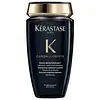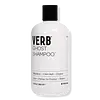What's inside
What's inside
 Key Ingredients
Key Ingredients

 Benefits
Benefits

 Concerns
Concerns

 Ingredients Side-by-side
Ingredients Side-by-side

Water
Skin ConditioningSodium Laureth Sulfate
CleansingCoco-Betaine
CleansingLaureth-5 Carboxylic Acid
CleansingCocamide Mipa
EmulsifyingSodium Chloride
MaskingIsostearyl Neopentanoate
EmollientPolyquaternium-10
PPG-5-Ceteth-20
EmulsifyingAmodimethicone
Sodium Benzoate
MaskingSodium Hydroxide
BufferingCitric Acid
BufferingPEG-55 Propylene Glycol Oleate
PEG-60 Hydrogenated Castor Oil
EmulsifyingSalicylic Acid
MaskingPropylene Glycol
HumectantBenzyl Salicylate
PerfumingHexyl Cinnamal
PerfumingBenzyl Alcohol
PerfumingLimonene
PerfumingButylene Glycol
HumectantCitronellol
PerfumingGeraniol
PerfumingTocopherol
AntioxidantBisabolol
Masking2-Oleamido-1,3-Octadecanediol
Skin ConditioningSafflower Glucoside
Hydroxycitronellal
PerfumingSodium Hyaluronate
HumectantAlteromonas Ferment Extract
Skin ConditioningBHT
AntioxidantSodium Citrate
BufferingParfum
MaskingCeramide AP
Skin ConditioningWater, Sodium Laureth Sulfate, Coco-Betaine, Laureth-5 Carboxylic Acid, Cocamide Mipa, Sodium Chloride, Isostearyl Neopentanoate, Polyquaternium-10, PPG-5-Ceteth-20, Amodimethicone, Sodium Benzoate, Sodium Hydroxide, Citric Acid, PEG-55 Propylene Glycol Oleate, PEG-60 Hydrogenated Castor Oil, Salicylic Acid, Propylene Glycol, Benzyl Salicylate, Hexyl Cinnamal, Benzyl Alcohol, Limonene, Butylene Glycol, Citronellol, Geraniol, Tocopherol, Bisabolol, 2-Oleamido-1,3-Octadecanediol, Safflower Glucoside, Hydroxycitronellal, Sodium Hyaluronate, Alteromonas Ferment Extract, BHT, Sodium Citrate, Parfum, Ceramide AP
Water
Skin ConditioningSodium Lauroyl Methyl Isethionate
CleansingCocamidopropyl Betaine
CleansingSodium Cocoyl Isethionate
CleansingSodium Lauroyl Sarcosinate
CleansingCocamidopropyl Hydroxysultaine
CleansingSaccharum Officinarum Extract
MoisturisingSimmondsia Chinensis Seed Oil
EmollientMoringa Oleifera Seed Oil
EmollientAloe Barbadensis Leaf Juice
Skin ConditioningCocodimonium Hydroxypropyl Hydrolyzed Rice Protein
Skin ConditioningChamomilla Recutita Flower Extract
MaskingCamellia Sinensis Leaf Extract
AntimicrobialHydrolyzed Vegetable Protein Pg-Propyl Silanetriol
Skin ConditioningCitrus Aurantium Dulcis Fruit Extract
MaskingCitrus Limon Fruit Extract
MaskingPyrus Malus Fruit Extract
Skin ConditioningLavandula Angustifolia Flower Extract
CleansingRosa Centifolia Flower Extract
AstringentHelianthus Annuus Seed Extract
Skin ConditioningHydrolyzed Soy Protein
HumectantHydrolyzed Quinoa
Skin ConditioningGlycol Distearate
EmollientPanthenol
Skin ConditioningParfum
MaskingCitric Acid
BufferingPPG-2 Hydroxyethyl Coco/Isostearamide
Coconut Acid
CleansingGuar Hydroxypropyltrimonium Chloride
Skin ConditioningGlycerin
HumectantCocamidopropylamine Oxide
CleansingCoco-Glucoside
CleansingGlyceryl Oleate
EmollientTrisodium Ethylenediamine Disuccinate
Tetrasodium Glutamate Diacetate
Silicone Quaternium-8
Sodium Isethionate
CleansingPolyquaternium-7
Sodium Laurate
CleansingPolyquaternium-44
Tetrasodium EDTA
Magnesium Nitrate
Cocamidopropyl Dimethylamine
EmulsifyingLactic Acid
BufferingSodium Sarcosinate
Sodium Hydroxide
BufferingSodium Glycolate
BufferingMagnesium Chloride
Ethylhexylglycerin
Skin ConditioningHydrogen Peroxide
AntimicrobialSodium Formate
BufferingTocopherol
AntioxidantHydrogenated Palm Glycerides Citrate
EmollientDisodium EDTA
Lecithin
EmollientAscorbyl Palmitate
AntioxidantPhenoxyethanol
PreservativeSodium Benzoate
MaskingMethylchloroisothiazolinone
PreservativeMethylisothiazolinone
PreservativePotassium Sorbate
PreservativeBenzyl Alcohol
PerfumingChlorphenesin
AntimicrobialSorbic Acid
PreservativeHydroxycitronellal
PerfumingButylphenyl Methylpropional
PerfumingLimonene
PerfumingWater, Sodium Lauroyl Methyl Isethionate, Cocamidopropyl Betaine, Sodium Cocoyl Isethionate, Sodium Lauroyl Sarcosinate, Cocamidopropyl Hydroxysultaine, Saccharum Officinarum Extract, Simmondsia Chinensis Seed Oil, Moringa Oleifera Seed Oil, Aloe Barbadensis Leaf Juice, Cocodimonium Hydroxypropyl Hydrolyzed Rice Protein, Chamomilla Recutita Flower Extract, Camellia Sinensis Leaf Extract, Hydrolyzed Vegetable Protein Pg-Propyl Silanetriol, Citrus Aurantium Dulcis Fruit Extract, Citrus Limon Fruit Extract, Pyrus Malus Fruit Extract, Lavandula Angustifolia Flower Extract, Rosa Centifolia Flower Extract, Helianthus Annuus Seed Extract, Hydrolyzed Soy Protein, Hydrolyzed Quinoa, Glycol Distearate, Panthenol, Parfum, Citric Acid, PPG-2 Hydroxyethyl Coco/Isostearamide, Coconut Acid, Guar Hydroxypropyltrimonium Chloride, Glycerin, Cocamidopropylamine Oxide, Coco-Glucoside, Glyceryl Oleate, Trisodium Ethylenediamine Disuccinate, Tetrasodium Glutamate Diacetate, Silicone Quaternium-8, Sodium Isethionate, Polyquaternium-7, Sodium Laurate, Polyquaternium-44, Tetrasodium EDTA, Magnesium Nitrate, Cocamidopropyl Dimethylamine, Lactic Acid, Sodium Sarcosinate, Sodium Hydroxide, Sodium Glycolate, Magnesium Chloride, Ethylhexylglycerin, Hydrogen Peroxide, Sodium Formate, Tocopherol, Hydrogenated Palm Glycerides Citrate, Disodium EDTA, Lecithin, Ascorbyl Palmitate, Phenoxyethanol, Sodium Benzoate, Methylchloroisothiazolinone, Methylisothiazolinone, Potassium Sorbate, Benzyl Alcohol, Chlorphenesin, Sorbic Acid, Hydroxycitronellal, Butylphenyl Methylpropional, Limonene
 Reviews
Reviews

Ingredients Explained
These ingredients are found in both products.
Ingredients higher up in an ingredient list are typically present in a larger amount.
Benzyl Alcohol is most commonly used as a preservative. It also has a subtle, sweet smell. Small amounts of Benzyl Alcohol is not irritating and safe to use in skincare products. Most Benzyl Alcohol is derived from fruits such as apricots.
Benzyl Alcohol has both antibacterial and antioxidant properties. These properties help lengthen the shelf life of products. Benzyl Alcohol is a solvent and helps dissolve other ingredients. It can also improve the texture and spreadability.
Alcohol comes in many different forms. Different types of alcohol will have different effects on skin. This ingredient is an astringent alcohol.
Using high concentrations of these alcohols are drying on the skin. They may strip away your skin's natural oils and even damage your skin barrier. Astringent alcohols may also irritate skin.
Other types of astringent alcohols include:
According to the National Rosacea Society based in the US, you should be mindful of products with these alcohols in the top half of ingredients.
Any type of sanitizing product will have high amounts of alcohol to help kill bacteria and viruses.
Learn more about Benzyl AlcoholCitric Acid is an alpha hydroxy acid (AHA) naturally found in citrus fruits like oranges, lemons, and limes.
Like other AHAs, citric acid can exfoliate skin by breaking down the bonds that hold dead skin cells together. This helps reveal smoother and brighter skin underneath.
However, this exfoliating effect only happens at high concentrations (20%) which can be hard to find in cosmetic products.
Due to this, citric acid is usually included in small amounts as a pH adjuster. This helps keep products slightly more acidic and compatible with skin's natural pH.
In skincare formulas, citric acid can:
While it can provide some skin benefits, research shows lactic acid and glycolic acid are generally more effective and less irritating exfoliants.
Most citric acid used in skincare today is made by fermenting sugars (usually from molasses). This synthetic version is identical to the natural citrus form but easier to stabilize and use in formulations.
Read more about some other popular AHA's here:
Learn more about Citric AcidHydroxycitronellal is a fragrance created from citronellal. The smell of hydroxycitronellal is often described as "citrus-like" or "melon-like".
Hydroxycitronellal is a known EU allergen and may cause irritation when applied to the skin.
Limonene is a fragrance that adds scent and taste to a formulation.
It's found in the peel oil of citrus fruits and other plants such as lavender and eucalyptus. The scent of limonene is generally described as "sweet citrus".
Limonene acts as an antioxidant, meaning it helps neutralize free radicals.
When exposed to air, oxidized limonene may sensitize the skin. Because of this, limonene is often avoided by people with sensitive skin.
The term 'fragrance' is not regulated in many countries. In many cases, it is up to the brand to define this term. For instance, many brands choose to label themselves as "fragrance-free" because they are not using synthetic fragrances. However, their products may still contain ingredients such as essential oils that are considered a fragrance.
Learn more about LimoneneParfum is a catch-all term for an ingredient or more that is used to give a scent to products.
Also called "fragrance", this ingredient can be a blend of hundreds of chemicals or plant oils. This means every product with "fragrance" or "parfum" in the ingredients list is a different mixture.
For instance, Habanolide is a proprietary trade name for a specific aroma chemical. When used as a fragrance ingredient in cosmetics, most aroma chemicals fall under the broad labeling category of “FRAGRANCE” or “PARFUM” according to EU and US regulations.
The term 'parfum' or 'fragrance' is not regulated in many countries. In many cases, it is up to the brand to define this term.
For instance, many brands choose to label themselves as "fragrance-free" because they are not using synthetic fragrances. However, their products may still contain ingredients such as essential oils that are considered a fragrance by INCI standards.
One example is Calendula flower extract. Calendula is an essential oil that still imparts a scent or 'fragrance'.
Depending on the blend, the ingredients in the mixture can cause allergies and sensitivities on the skin. Some ingredients that are known EU allergens include linalool and citronellol.
Parfum can also be used to mask or cover an unpleasant scent.
The bottom line is: not all fragrances/parfum/ingredients are created equally. If you are worried about fragrances, we recommend taking a closer look at an ingredient. And of course, we always recommend speaking with a professional.
Learn more about ParfumSodium Benzoate is a preservative. It's used in both cosmetic and food products to inhibit the growth of mold and bacteria. It is typically produced synthetically.
Both the US FDA and EU Health Committee have approved the use of sodium benzoate. In the US, levels of 0.1% (of the total product) are allowed.
Sodium benzoate works as a preservative by inhibiting the growth of bacteria inside of cells. It prevents the cell from fermenting a type of sugar using an enzyme called phosphofructokinase.
It is the salt of benzoic acid. Foods containing sodium benzoate include soda, salad dressings, condiments, fruit juices, wines, and snack foods.
Studies for using ascorbic acid and sodium benzoate in cosmetics are lacking, especially in skincare routines with multiple steps.
We always recommend speaking with a professional, such as a dermatologist, if you have any concerns.
Learn more about Sodium BenzoateSodium Hydroxide is also known as lye or caustic soda. It is used to adjust the pH of products; many ingredients require a specific pH to be effective.
In small amounts, sodium hydroxide is considered safe to use. However, large amounts may cause chemical burns due to its high alkaline.
Your skin has a natural pH and acid mantle. This acid mantle helps prevent harmful bacteria from breaking through. The acid mantle also helps keep your skin hydrated.
"Alkaline" refers to a high pH level. A low pH level would be considered acidic.
Learn more about Sodium HydroxideTocopherol (also known as Vitamin E) is a common antioxidant used to help protect the skin from free-radicals and strengthen the skin barrier. It's also fat soluble - this means our skin is great at absorbing it.
Vitamin E also helps keep your natural skin lipids healthy. Your lipid skin barrier naturally consists of lipids, ceramides, and fatty acids. Vitamin E offers extra protection for your skin’s lipid barrier, keeping your skin healthy and nourished.
Another benefit is a bit of UV protection. Vitamin E helps reduce the damage caused by UVB rays. (It should not replace your sunscreen). Combining it with Vitamin C can decrease sunburned cells and hyperpigmentation after UV exposure.
You might have noticed Vitamin E + C often paired together. This is because it is great at stabilizing Vitamin C. Using the two together helps increase the effectiveness of both ingredients.
There are often claims that Vitamin E can reduce/prevent scarring, but these claims haven't been confirmed by scientific research.
Learn more about TocopherolWater. It's the most common cosmetic ingredient of all. You'll usually see it at the top of ingredient lists, meaning that it makes up the largest part of the product.
So why is it so popular? Water most often acts as a solvent - this means that it helps dissolve other ingredients into the formulation.
You'll also recognize water as that liquid we all need to stay alive. If you see this, drink a glass of water. Stay hydrated!
Learn more about Water